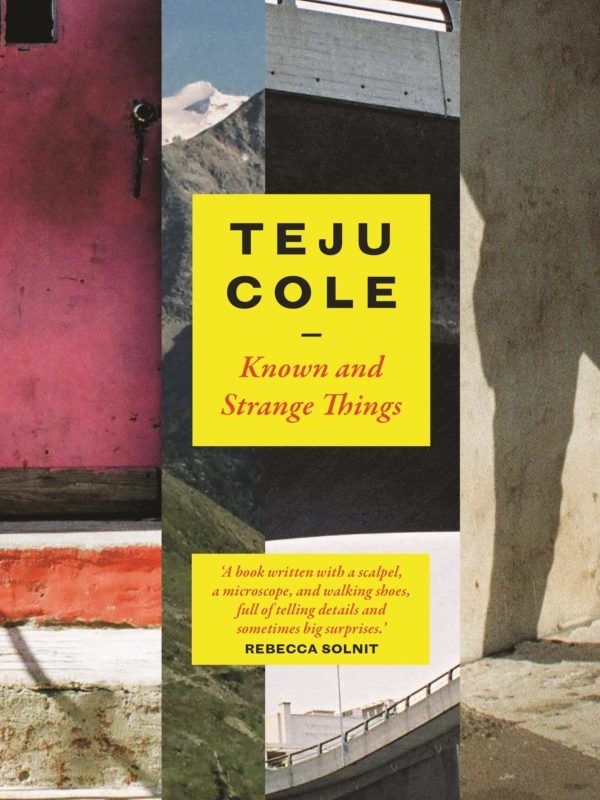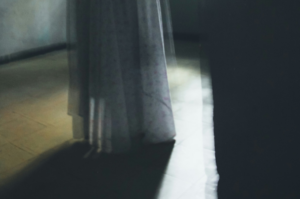In Teju Cole’s new book, Known and Strange Things, there are 50+ essays. Cole is a busy writer. In the last 8 years, he has written lots of essays and literary sketches, all of which are scattered across various publications, online sites, and social media platforms. Known and Strange Things is the first attempt to collect some of these writings in one place.
The book is an intimate encounter with Cole’s intellectual universe. It covers his many ideas about politics and aesthetics. It’s thrilling to work through the collection of essays, in part, because it feels like walking through a magician’s den and being dazzled by an expansive collection of images, objects, ideas, spaces, and questions.
Writing is, for Cole, in the most literal sense, an act of collecting. Little wonder that Known and Strange Things is a book about almost everything: Ebola, the 2008 American election, Wole Soyinka, Google, Goethe, blackness, blindness, Sebald, Simone de Beauvoir, Dame Patience Jonathan, Beowulf, Boko Haram, and a host of many others things.
Perhaps because of this encyclopedic texture, the essays can come across as brainy and scholarly. To the initiated reader, watching Cole geek out on all his signature intellectual interests can be illuminating and fun. But to the reader with a taste for the light and the fluffy side of intellectual thought, these essays might feel a bit crusty. You might find yourself lost in a sea of unfamiliar references to classical music, obscure European towns, strange literary works, and time periods no one cares to talk about.
Don’t despair. There are a number of lovely moments—moments of inspiring insights, moments when Cole says things that touch on the little joys of everyday life—a few of which we have selected for your enjoyment.
***
ON SELFIES — “Portrait of a Lady”
For those days when you need a lesson on how to take the perfect selfie, flip to the first full paragraph on page 127. “A visual soliloquy” is what Cole calls it. He is describing one of Seydou Keita’s masterpieces, but there’s a enough tips on how to give Kim Kardashian, the Selfie Queen, a run for her money. Recline on a bed. Make sure your makeup is on point. Your face should be striking. Rest your head on your arm. Narrow your eyes. Remember that you’re going for self-possessed look not seductive. Avoid looking into the camera. You should look beyond it. You want to strike the vacant, “I don’t give a damn about anyone but myself” look. That’s it. Now click the camera button.
ON DIGITAL DETOX — “Touching Strangers”
In a world of communication gadget and social media obsession, it’s easy to forget the power of touching. Thanks to social media apps and mobile phones, we see images of people we love. We read things they write. We hear recordings of their voices. But Cole’s essay reminds us that touching them is different. Touching, he explains, “is a sense that goes both ways: the sensitivity of one’s skin responds to and is responded to by the sensitivity of other people’s skin.” It’s a two-way thing. When all the snaps and instragram posts and tweets are all sent and done with, we still need to feel that two way mystery and power of touching someone. Lesson: drop that phone once in a while, reach out and touch someone.
A CASE FOR SCRAPBOOKING — “Finders Keepers”
Here is all the motivation you need to organize the gazillion photographs you have stored on your phone and various cloud apps. The essay opens with a scary truth that we know all too well: we are a camera-obsessed generation. “Nearly one trillion photographs are taken every year,” Cole observes. Yes, the hundreds of photos on your phone make up a sizable part of that scarily large number. Now that the Iphone 7 has increased the storage space on phones to 256 gigs, expect things to get worse. Let Cole’s essay be a reminder that storage is not the same as memory. The act of storing images and videos on your phone is different from actively transforming these stored items into a meaningful account of life. Think of your phone or icloud storage unit as an abyss where everything enters and risks being forgotten. At some point you have to look through and begin to find ways to assemble these things you’ve stored into meaningful accounts of your past.
TOOLS FOR DATING IN THE 21ST CENTURY — “The Unquiet Sky”
There is this moment in “The Unquiet Sky” when Cole dishes on the ultimate stalking tool—Google Earth. Cole says he does this only when he is missing his parents who live in Lagos. “I go to Google Maps and trace the highway that leads to our family house in the northern part of the city. I find our street amidst the complicated jumble of brown lines just east of the bus terminal. I can make out the shape of the house, the tree in front of it, the surrounding fence. I hover there, “visiting home.” But this tool need not be used only for “visiting home.” It opens up a whole new dimension in the relationship between technology and intimacy. If Google Earth can abolish the distance between self and home, it could fulfill other desires for intimacy as well. We can think of a thousand other, not so appropriate uses for such a tool—like keeping up with a secret crush.
ELECTION JITTERS — “The Reprint”
The 2016 presidential election in the US is all done and gone. For those who felt like their side lost, election day and the day after had to have been rough. But it didn’t have to be. In “Reprint,” Cole gives us a detailed rundown of what he did on the day Obama won the 2008 presidential election. It contains some useful tips on how to survive the tension of an election day and prepare yourself for the outcome. Here is what you do: reserve a seat in your favorite bar. Invite friends to join you before hand. Arrive there a little before. Order some beer and dig into a dinner of “catfish stuffed with shrimps and a side of collard greens and yams.” Whoever wins, you’ll have the extra energy to either jubilate or weep.
ON CREATIVITY — “Wangechi Mutu”
How do you write or create art in a way that “escapes foolish stereotypes?” The first step is to break the habit of seeking out familiar things. Open yourself up to unconventional things. In this essay on the Kenyan artist Wangechi Mutu, Cole points to a certain mysterious quality of her work that comes from her attraction to discarded and forgotten things—like myths, folktales—things that people see as past or backward or strange and as a result as irrelevant to our contemporary world. She assembles these objects and images, and surprising things happen. The most magical work can emerge from the most ordinary idea.










Ainehi Edoro November 26, 2016 00:06
@Judith, Thank you so much for your kind words. A real shot in the arm!